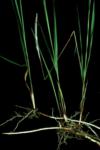Latin name
Imperata cylindrica (L.) Raeuschel
Family
Poaceae
Common name(s)
Alang-alang, bladygrass, cogongrass, and swordgrass
Synonym(s)
Imperata allang Junghuhn, I. arundinacea Cyr., Lagurus cylindricus L. (basionym), Saccharum cylindricum (L.) Lam., S. koenigii Retz., S. thunbergii Retz., S. europeaum Pers., Lagurus cylindricus L., Calamagrostis lagurus (L.) Koeler
Geographical distribution
Asia: China (including Taiwan) and Japan.
South and Southeast Asia: Bangladesh, India, Indonesia, Lao PDR, Malaysia, Nepal, Philippines, Sri Lanka, Thailand, and Vietnam.
Rest of the world: Australia, Egypt, Fiji, Iran, Iraq, Kenya, Madagascar, Mauritius, New Zealand, Papua New Guinea, Republic of Congo, Soviet Union (former), Spain, Sudan, Syria, Tanzania, United States, West Africa, Zambia, and Zimbabwe.
Morphology
A perennial, unbranched grass with well-developed scaly rhizomes, with sharp, hard, reddish points, 20—150—cm—tall.
Stem: culms erect, tufted and arising from an extensive system of tough-branched, white, and succulent rhizomes, with 2—5 nodes; nodes glabrous or bearded.
Leaf: linear lance-shaped, up to 150—cm in length and 4—18—mm—wide; base glabrous or hairy; margins of sheaths smooth or hairy; ligule short and truncate, 1—8—mm—long.
Inflorescence: dense, silvery-silky "spike-like" panicles, 3—20—cm—long; spikelets paired, lance-shaped or oblong, 3—6—mm—long, surrounded by silky hairs.
Biology and ecology
Common in field and river margins, grasslands, cultivated annual crops, and plantations. It prefers fertile soils but can also thrive under low fertility. Prefers light conditions but can also survive in 50% shade.
Propagated vegetatively from numerous rhizomes and by seeds.
Agricultural importance
An important weed that has replaced forest cover over large areas of Southeast Asia as the land has been cleared. It is fire resistant and able to grow back rapidly from the rhizomes after burning. It is often one of the first species to grow back after burning, commonly to the exclusion of others.
The weed is a host of diseases caused by Rhizoctonia solani and Thanatephorus cucumeris. It also harbors the root-knot nematode Rotylenchus reniformis and the rust fungus Puccinia rufipes.
It is useful as a soil binder to prevent soil erosion and for thatching. It is also used medicinally.
Management
Cultural control: frequent cultivation using hand tools, animal-drawn equipment, and machine-powered cultivators may control the weed. The grass is not very tolerant of shading and shrub or creeping legumes can be used to replace the grass if the cycle of dry-season burning has been broken.
Chemical control: Glyphosate as preplant treatment gives effective control.
Selected references
Galinato I, Moody K, Piggin. CM. 1999. Upland rice weeds of South and Southeast Asia. Manila (Philippines): International Rice Research Institute. 156 p.Holm LG, Plucknett DL, Pancho JV, Herberger JP. 1977. The world's worst weeds: distribution and biology. Honolulu, Hawaii (USA): University of Hawaii Press. 609 p.Hsu C. 1978. Gramineae (Poaceae). Flora of Taiwan. 5:373-783.Merrill ED. 1976. A flora of Manila. Manila (Philippines): Department of the Interior, Bureau of Science. 491 p.Moody K. 1989. Weeds reported in rice in South and Southeast Asia. Manila (Philippines): International Rice Research Institute. 442 p.Moody K, Munroe CE, Lubigan RT, Paller Jr. EC. 1984. Major weeds of the Philippines. Weed Science Society of the Philippines. College, Laguna (Philippines): University of the Philippines at Los Baños. 328 p.Pancho JV, Obien SR. 1995. Manual of ricefield weeds in the Philippines. Muñoz, Nueva Ecija (Philippines): Philippine Rice Research Institute. 543 p.W3TROPICOS at http://mobot.mobot.org/Pick/Search/pick.html.
Contributors
JLA Catindig, RT Lubigan, and DE Johnson
